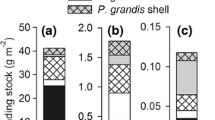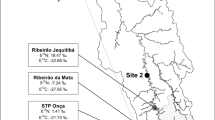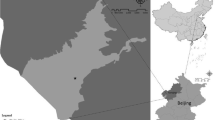Abstract
The flux of consumer-derived nutrients is recognized as an important ecosystem process, yet few studies have quantified the impact of these fluxes on freshwater ecosystems. The high abundance of bivalves in both marine and freshwater suggests that bivalves can exert large effects on aquatic food webs. The objective of our study was to determine the importance of unionid mussel-derived nitrogen (MDN) to the food web. We used a stable isotope tracer approach in conjunction with nutrient uptake and excretion experiments. We fed mussels (Lampsilis siliquiodea, n = 249) a 15N-enriched algal diet and placed them into a N-limited stream for 63 days. Mussel hemolymph was non-lethally sampled over the course of the experiment to measure tissue turnover of δ15N and excretion experiments were done to model the amount of N mussels provided in comparison to stream N uptake demand. Multiple food web pools were sampled twice prior and five times following the mussel addition to trace the 15N through the food web. Our mussel excretion rates in comparison to areal uptake demand suggested that mussel excretion can account for 40% of the total N demand in this stream. Our enrichment showed that MDN was entering the food web and supplied up to 19% of the N in specific compartments of the food web near the mussel bed. When scaled to a natural mussel aggregation, our results suggest up to 74% of N in the food web may be mussel-derived. Our results show that N supplied by mussels can be an important nutrient subsidy that provides food web support.





Similar content being viewed by others
References
Allen D, Vaughn C. 2011. Density-dependent biodiversity effects on physical habitat modification by freshwater bivalves. Ecology 92:1013–19.
Allen DC, Vaughn CC, Kelly JF, Cooper JT, Engel M. 2012. Bottom-up biodiversity effects increase resource subsidy flux between ecosystems. Ecology 93:2165–74.
Allgeier JE, Yeager LA, Layman CA. 2013. Consumers regulate nutrient limitation regimes and primary production in seagrass ecosystems. Ecology 94:521–9.
APHA. 1995. Standard methods for the examination of water and sewage. Washington, DC: American Public Health Association.
Aquilino KM, Bracken MES, Faubel MN, Stachowicz JJ. 2009. Local-scale nutrient regeneration facilitates seaweed growth on wave-exposed rocky shores in an upwelling system. Limnology and Oceanography 54:309–17.
Atkinson CL, First MR, Covich AP, Opsahl SP, Golladay SW. 2011. Suspended material availability and filtration-biodeposition processes performed by a native and invasive bivalve species in streams. Hydrobiologia 667:191–204.
Atkinson CL, Julian JP, Vaughn CC. 2012. Scale-dependent longitudinal patterns in mussel communities. Freshwater Biology 57:2272–84.
Atkinson CL, Vaughn CC, Forshay KJ, Cooper JT. 2013. Aggregated filter-feeding consumers alter nutrient limitation: consequences for ecosystem and community dynamics. Ecology 94:1359–69.
Benstead JP, Cross WF, March JG, McDowell WH, Ramirez A, Covich AP. 2010. Biotic and abiotic controls on the ecosystem significance of consumer excretion in two contrasting tropical streams. Freshwater Biology 55:2047–61.
Bogan AE. 2008. Global diversity of freshwater mussels (Mollusca, Bivalvia) in freshwater. Hydrobiologia 595:139–47.
Bruesewitz DA, Tank JL, Hamilton SK. 2009. Seasonal effects of zebra mussels on littoral nitrogen transformation rates in Gull Lake, Michigan, USA. Freshwater Biology 54:1427–43.
Capps KA, Flecker AS. 2013. Invasive fishes generate biogeochemical hotspots in a nutrient-limited system. PLoS One 8:e54093.
Dame RF. 2011. Ecology of marine bivalves: an ecosystem approach. Boca Raton, FL: CRC Press.
Dodds WK. 1997. Distribution of runoff and rivers related to vegetative characteristics, latitude, and slope: a global perspective. Journal of the North American Benthological Society 16:162–8.
Dodds WK, Evans-White MA, Gerlanc NM, Gray L, Gudder DA, Kemp MJ, Lopez AL, Stagliano D, Strauss EA, Tank JL, Whiles MR, Wollheim WM. 2000. Quantification of the nitrogen cycle in a prairie stream. Ecosystems 3:574–89.
Dodds WK, Lopez AJ, Bowden WB, Gregory S, Grimm NB, Hamilton SK, Hershey AE, Marti E, McDowell WH, Meyer JL, Morrall D, Mulholland PJ, Peterson BJ, Tank JL, Valett HM, Webster JR, Wollheim W. 2002. N uptake as a function of concentration in streams. Journal of the North American Benthological Society 21:206–20.
Dortch Q. 1990. The interaction between ammonium and nitrate uptake in phytoplankton. Marine Ecology Progress Series 61:183–201.
Flecker AS, Taylor BW, Bernhardt ES, Hood JM, Cornwell WK, Cassatt SR, Vanni MJ, Altman NS. 2002. Interactions between herbivorous fishes and limiting nutrients in a tropical stream ecosystem. Ecology 83:1831–44.
Goedkoop W, Naddafi R, Grandin U. 2011. Retention of N and P by zebra mussels (Dreissena polymorpha Pallas) and its quantitative role in the nutrient budget of eutrophic Lake Ekoln, Sweden. Biological Invasions 13:1077–86.
Grimm NB. 1988. Role of macroinvertebrates in nitrogen dynamics of a desert stream. Ecology 69:1884–93.
Gustafson L, Showers W, Kwak T, Levine J, Stoskopf M. 2007. Temporal and spatial variability in stable isotope compositions of a freshwater mussel: implications for biomonitoring and ecological studies. Oecologia 152:140–50.
Gutierrez JL, Jones CG, Strayer DL, Iribarne OO. 2003. Mollusks as ecosystem engineers: the role of shell production in aquatic habitats. Oikos 101:79–90.
Haag WR. 2012. North American freshwater mussels: ecology, natural history, and conservation. New York, NY: Cambridge University Press.
Helfield JM, Naiman RJ. 2001. Effects of salmon-derived nitrogen on riparian forest growth and implications for stream productivity. Ecology 82:2403–9.
Hesslein RH, Hallard KA, Ramlal P. 1993. Replacement of sulfur, carbon, and nitrogen in tissue of growing broad whitefish (Coregonus nasus) in response to a change in diet traced by δ34S, δ13C, and δ15N. Canadian Journal of Fisheries and Aquatic Sciences 50:2071–6.
Hobson KA, Clark RG. 1992. Assessing avian diets using stable isotopes. 1. Turnover of C-13 in tissues. Condor 94:181–8.
Hooper DU, Adair EC, Cardinale BJ, Byrnes JEK, Hungate BA, Matulich KL, Gonzalez A, Duffy JE, Gamfeldt L, O’Connor MI. 2012. A global synthesis reveals biodiversity loss as a major driver of ecosystem change. Nature 486(7401):105–8.
Howard JK, Cuffey KM. 2006. The functional role of native freshwater mussels in the fluvial benthic environment. Freshwater Biology 51:460–74.
Jansen HM, Strand O, Strohmeier T, Krogness C, Verdegem M, Smaal A. 2011. Seasonal variability in nutrient regeneration by mussel Mytilus edulis rope culture in oligotrophic systems. Marine Ecology Progress Series 431:137–49.
Kemp PF, Newell SY, Hopkinson CS. 1990. Importance of grazing on the salt-marsh grass, Spartina alterniflora, to nitrogen turnover in a macrofaunal consumer, Littorina irrorata, and to decomposition of standing dead Spartina. Marine Biology 104:311–19.
Knapp AK, Blair JM, Briggs JM, Collins SL, Hartnett DC, Johnson LC, Towne EG. 1999. The keystone role of bison in North American tallgrass prairie: Bison increase habitat heterogeneity and alter a broad array of plant, community, and ecosystem processes. Bioscience 49:39–50.
MacAvoy SE, Macko SA, Garman GC. 2001. Isotopic turnover in aquatic predators: quantifying the exploitation of migratory prey. Canadian Journal of Fisheries and Aquatic Sciences 58:923–32.
McIntyre PB, Flecker AS. 2006. Rapid turnover of tissue nitrogen of primary consumers in tropical freshwaters. Oecologia 148:12–21.
McIntyre PB, Flecker AS, Vanni MJ, Hood JM, Taylor BW, Thomas SA. 2008. Fish distributions and nutrient cycling in streams: can fish create biogeochemical hotspots? Ecology 89:2335–46.
McIntyre PB, Jones LE, Flecker AS, Vanni MJ. 2007. Fish extinctions alter nutrient recycling in tropical freshwaters. Proceedings of the National Academy of Sciences of the United States of America 104:4461–6.
Meyer JL. 1994. The microbial loop in flowing waters. Microbial Ecology 28:195–9.
Molvar EM, Bowyer RT, Van Ballenberghe V. 1993. Moose herbivory, browse quality, and nutrient cycling in an Alaskan treeline community. Oecologia (Heidelberg) 94:473–9.
Moore JW. 2006. Animal ecosystem engineers in streams. Bioscience 56:237–46.
Mulholland PJ, Tank JL, Sanzone DM, Wollheim WM, Peterson BJ, Webster JR, Meyer JL. 2000. Food resources of stream macroinvertebrates determined by natural-abundance stable C and N isotopes and a N-15 tracer addition. Journal of the North American Benthological Society 19:145–57.
Mulholland PJ, Tank JL, Webster JR, Bowden WB, Dodds WK, Gregory SV, Grimm NB, Hamilton SK, Johnson SL, Marti E, McDowell WH, Merriam JL, Meyer JL, Peterson BJ, Valett HM, Wollheim WM. 2002. Can uptake length in streams be determined by nutrient addition experiments? Results from an interbiome comparison study. Journal of the North American Benthological Society 21:544–60.
Newbold JD, Elwood JW, Oneill RV, Vanwinkle W. 1981. Measuring nutrient spiralling in streams. Canadian Journal of Fisheries and Aquatic Sciences 38:860–3.
Polis GA, Power ME, Huxel GR. 2004. Food webs at the landscape level. Chicago, IL: University of Chicago Press.
Porter ET, Cornwell JC, Sanford LP. 2004. Effect of oysters Crassostrea virginica and bottom shear velocity on benthic–pelagic coupling and estuarine water quality. Marine Ecology Progress Series 271:61–75.
Schmitz OJ, Hawlena D, Trussell GC. 2010. Predator control of ecosystem nutrient dynamics. Ecology Letters 13:1199–209.
Small GE, Helton AM, Kazanci C. 2009. Can consumer stoichiometric regulation control nutrient spiraling in streams? Journal of the North American Benthological Society 28:747–65.
Small GE, Pringle CM, Pyron M, Duff JH. 2011. Role of the fish Astyanax aeneus (Characidae) as a keystone nutrient recycler in low-nutrient Neotropical streams. Ecology 92:386–97.
Spooner DE, Frost PC, Hillebrand H, Arts MT, Puckrin O, Xenopoulos MA. 2013. Nutrient loading associated with agriculture land use dampens the importance of consumer-mediated niche construction. Ecology Letters. doi:10.1111/ele.12146.
Spooner DE, Vaughn CC. 2006. Context-dependent effects of freshwater mussels on stream benthic communities. Freshwater Biology 51:1016–24.
Spooner DE, Vaughn CC, Galbraith HS. 2012. Species traits and environmental conditions govern the relationship between biodiversity effects across trophic levels. Oecologia 168:533–48.
Strayer DL. 2008. Freshwater mussel ecology: a multifactor approach to distribution and abundance. Berkeley, CA: University of California Press.
Strayer DL. 2013. Understanding how nutrient cycles and freshwater mussels (Unionoida) affect one another. Hydrobiologia. doi:10.1007/s107050-013-1461-5.
Strayer DL, Downing JA, Haag WR, King TL, Layzer JB, Newton TJ, Nichols SJ. 2004. Changing perspectives on pearly mussels, North America’s most imperiled animals. Bioscience 54:429–39.
Tank JL, Bernot MJ, Rosi-Marshall EJ. 2006. Nitrogen limitation and uptake. In: Hauer FR, Lamberti GA, Eds. Methods in Stream Ecology. San Diego, CA: Academic Press.
Tank JL, Rosi-Marshall EJ, Baker MA, Hall RO. 2008. Are rivers just big streams? A pulse method to quantify nitrogen demand in a large river. Ecology 89:2935–45.
Tieszen LL, Boutton TW, Tesdahl KG, Slade NA. 1983. Fractionation and turnover of stable carbon isotopes in animal tissues: implications for delta-C analysis of diet. Oecologia 57:32–7.
Vanni MJ. 2002. Nutrient cycling by animals in freshwater ecosystems. Annual Review of Ecology and Systematics 33:341–70.
Vanni MJ, Flecker AS, Hood JM, Headworth JL. 2002. Stoichiometry of nutrient recycling by vertebrates in a tropical stream: linking species identity and ecosystem processes. Ecology Letters 5:285–93.
Vaughn CC. 2010. Biodiversity losses and ecosystem function in freshwaters: emerging conclusions and research directions. Bioscience 60:25–35.
Vaughn CC, Nichols SJ, Spooner DE. 2008. Community and foodweb ecology of freshwater mussels. Journal of the North American Benthological Society 27:409–23.
Vaughn CC, Spooner DE. 2006. Unionid mussels influence macroinvertebrate assemblage structure in streams. Journal of the North American Benthological Society 25:691–700.
Vaughn CC, Spooner DE, Galbraith HS. 2007. Context-dependent species identity effects within a functional group of filter-feeding bivalves. Ecology 88(7):1654–62.
Whiles MR, Hall RO, Dodds WK, Verburg P, Huryn AD, Pringle CM, Lips KR, Kilham SS, Colon-Gaud C, Rugenski AT, Peterson S, Connelly S. 2013. Disease-driven amphibian declines alter ecosystem processes in a tropical stream. Ecosystems 16:146–57.
Wotton RS, Malmqvist B, Leonardsson K. 2003. Expanding traditional views on suspension feeders: quantifying their role as ecosystem engineers. Oikos 101:441–3.
Zerba KE, Collins JP. 1992. Spatial heterogeneity and individual variation in diet of an aquatic top predator. Ecology 73:268–79.
Acknowledgments
We thank Tiffany Crumrine for assistance with placing the mussels in the stream and sampling assistance. Jesse Tanner helped during one of the sampling periods. Robert Hall and Dan Allen both provided excellent advice prior to the experiment. Walter Dodds, Michael Patten, and Stephen Golladay provided invaluable comments on previous drafts of this manuscript. Ken Forshay at the Robert S. Kerr Laboratory provided the pumps and automatic samplers for the N uptake experiments, and Ashley McElmurry helped locate the equipment. C. Atkinson was supported in part by the United States Environmental Protection Agency (EPA) under the Science to Achieve Results (STAR) Graduate Fellowship Program. EPA has not officially endorsed this publication, and the views expressed herein may not reflect the views of the EPA. This paper was completed as part of a dissertation at the University of Oklahoma and is a contribution to the program of the Oklahoma Biological Survey.
Author information
Authors and Affiliations
Corresponding author
Additional information
Author Contributions
CLA designed and carried out field research and sample processing, and performed all statistical analyses. JFK assisted with data analysis and sample processing. CCV assisted with the design of the study and with sample collection. CLA wrote the first draft of the manuscript, and all other authors contributed substantially to revisions.
Electronic supplementary material
Below is the link to the electronic supplementary material.
Rights and permissions
About this article
Cite this article
Atkinson, C.L., Kelly, J.F. & Vaughn, C.C. Tracing Consumer-Derived Nitrogen in Riverine Food Webs. Ecosystems 17, 485–496 (2014). https://doi.org/10.1007/s10021-013-9736-2
Received:
Accepted:
Published:
Issue Date:
DOI: https://doi.org/10.1007/s10021-013-9736-2




